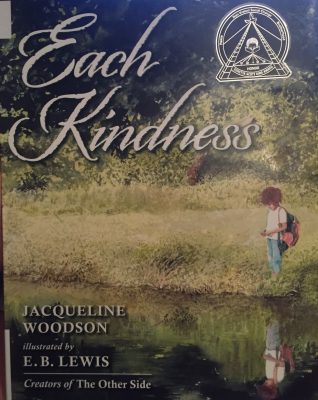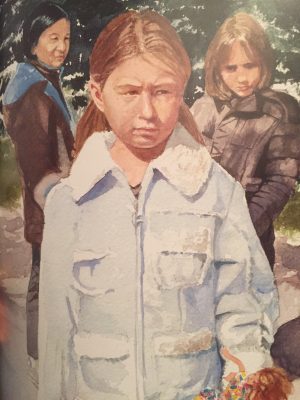- Title: Each Kindness
- Author(s): Jaqueline Woodson
- Illustrator/Photographer: E.B. Lewis
- Publisher and Year: The Penguin Group, 2012
- Number of pages: 30
- Tags: Award Book, Diversity, Emotion, Picture Book, Fiction, K-5, Morgan Houk
- Genre: Realistic Fiction
- Analysis:
This book is told from the perspective of a young girl named Chloe. Chloe gets a new girl, Maya, in her class but she looks different from the rest of the class. Her clothes are worn out, her hair is dirty, and she eats weird food at lunch. Chloe and the rest of her classmates do not talk to Maya or include her in any games at recess. One day, Maya is gone from school and Chloe’s teacher decides to give a lesson on kindness. She has her students drop stones into a big bucket and say one kind thing that they have done in the past week. The students watch the ripple of their stone in the water and see what an impact their little act of kindness can make. Chloe is unable to think of a kind thing she has done so she passes her stone to someone else. She becomes very guilty, thinking about Maya, and really hopes she comes back to school tomorrow so she can start including her. But, Maya went to a different school now and Chloe is left thinking of the many ways she could have been kind to her.
young girl named Chloe. Chloe gets a new girl, Maya, in her class but she looks different from the rest of the class. Her clothes are worn out, her hair is dirty, and she eats weird food at lunch. Chloe and the rest of her classmates do not talk to Maya or include her in any games at recess. One day, Maya is gone from school and Chloe’s teacher decides to give a lesson on kindness. She has her students drop stones into a big bucket and say one kind thing that they have done in the past week. The students watch the ripple of their stone in the water and see what an impact their little act of kindness can make. Chloe is unable to think of a kind thing she has done so she passes her stone to someone else. She becomes very guilty, thinking about Maya, and really hopes she comes back to school tomorrow so she can start including her. But, Maya went to a different school now and Chloe is left thinking of the many ways she could have been kind to her.
This book touches on many of the theoretical frameworks that we have discussed in class. The story told can act as a mirror for many students. Students will either be able to relate to Maya because they have, at some point in their lives, felt excluded and left out by others, or students will be able to relate to Chloe and think about a time that they could have stood up for someone and included them in an activity. The story can also act as a window into the life of a child that is living in poverty. Maya wears a lot of the same ratted clothes every day and her lunches look far different from her classmates. This could also be a mirror for some students as well. I also really like the way that poverty is represented in this book. For students, this is exactly how they are going to experience poverty, either first-hand (Maya) or second (Chloe), and the book teaches children the appropriate way to treat another person under these circumstances and beyond. In terms of a door for students, I would hope students would read this book and start treating one another with kindness so they never regret not being nice to someone like Chloe did.
The ideological framework of this book discusses the issue of power in relation to money. It is clear, in the story, that Maya comes from a family that does not have a lot of money and she is ridiculed for it by her classmates. Maya’s classmates come from families that are better off than she is, thus, resulting in a powerless Maya alone in a class full of powerful peers.
I find the perceptual framework of the book to be very intriguing. The illustrations are  created using water colors and the colors used are very light and soft across the page with no dark outlines. Even though the plot of the story is upsetting, the illustrations appear to make it not as heavy of a story line. Maya is often facing the reader while her classmates have her back to the reader and are all on the opposite side of the page as Maya. This really highlights the isolation that Maya feels while at school. Chloe is typically the focal point of the page being drawn larger than her classmates and in the center of the page, indicating the power she holds over her classmates.
created using water colors and the colors used are very light and soft across the page with no dark outlines. Even though the plot of the story is upsetting, the illustrations appear to make it not as heavy of a story line. Maya is often facing the reader while her classmates have her back to the reader and are all on the opposite side of the page as Maya. This really highlights the isolation that Maya feels while at school. Chloe is typically the focal point of the page being drawn larger than her classmates and in the center of the page, indicating the power she holds over her classmates.
